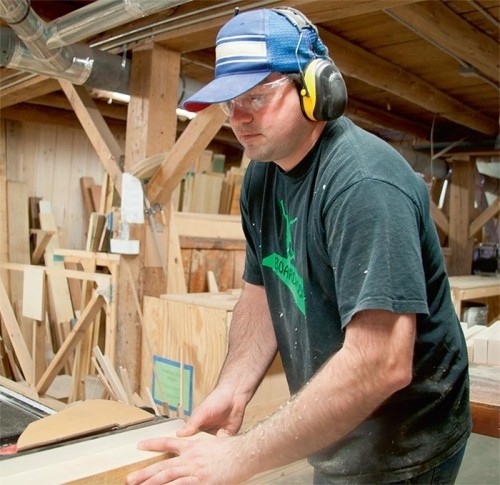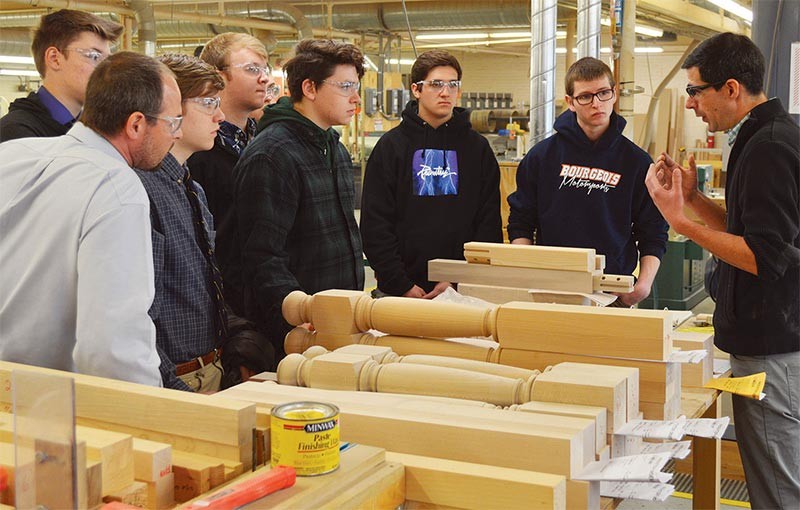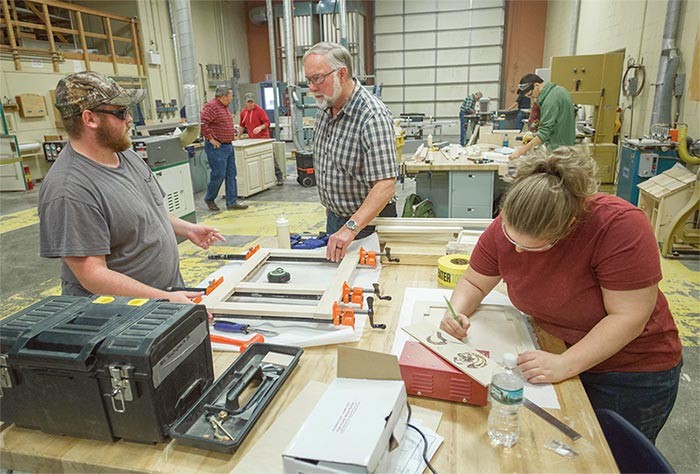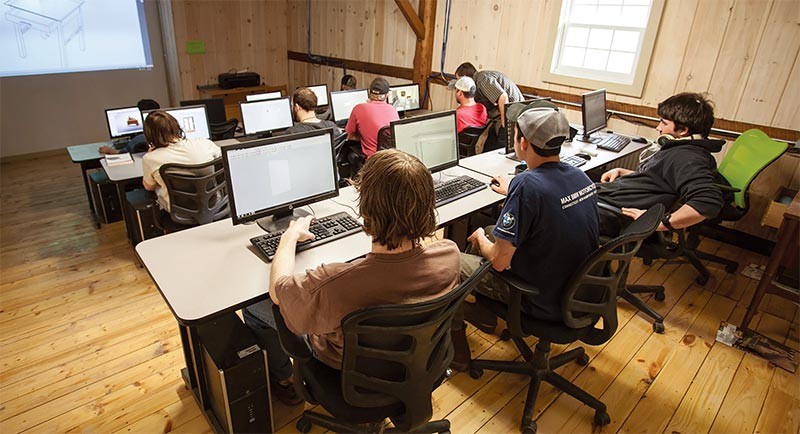On a Tuesday morning near the end of the school year, a half-dozen students move purposefully through the woodshop at St. Johnsbury Academy. Machines whirr, and the sweet scent of sawdust sifts through the air. One student turns a bowl on a lathe. Another fits together pieces of a headboard. Others measure and cut boards and sand edges smooth.
Most of these students are seniors who will graduate in a couple of weeks. Some will go on to college and consider woodworking a lifelong – and useful – hobby. Others hope to make it their life’s work.
Northern New England is not a bad place to pursue a career that involves working with wood; from boat building companies to furniture makers, there is strong demand for skilled workers. But it’s not always simple to walk out of the woodshop and into a job.
“We’re finding there’s a disconnect between the schools and industry needs,” said Dave Redmond, director of Wood Products Initiatives for the Northern Forest Center, which orchestrates a number of programs aimed at building economic and community vitality while fostering sound forest stewardship in northern New England and New York. “Industry needs continue to grow, and they’re almost at a crisis.”
To highlight the challenges, Redmond points out that the 40 wood-product manufacturers in Maine he’s visited recently employ nearly 3,000 people. Collectively, they’re actively seeking 400 employees to fill vacancies. It’s an ongoing struggle, and one with a variety of components, primarily a decreased emphasis over the years on vocational tech programs at the high school level and an evolving industry that relies increasingly on computerization and “soft skills” like communication and workplace cohesion - often missing from the curriculum in woodworking programs. Woodworking schools and programs are striving to bridge the gap between the woodshop and the twenty-first-century workplace. Three different schools in the region have three different points of focus in training the next generation of woodworkers.
St. Johnsbury Academy
When Matthew Stark came on board as the woodworking instructor at this high school in northern Vermont five years ago, there were seven students enrolled in woodworking classes. This fall, Stark expects to teach about 130 students – nearly 15 percent of the student body.
“The students just really love creating,” said Stark, who graduated from St. Johnsbury Academy in 1996 and moved west to California, where he apprenticed with an established furniture maker before setting up his own custom shop. He still makes custom pieces and credits that real-world experience as one part of the growth of the program at his alma mater.
“The students see me not only as a teacher, but as somebody who has come through the trades and had a very successful business,” he said. “It’s all about trust.”
Stark encourages his students to create to their hearts’ content – once they have the skills needed to do so. They begin with a simple project: making a jewelry box while learning to use basic woodworking equipment and techniques in the process. They move on to side tables then personal projects. Students in advanced classes design and create their own furniture, often custom pieces for faculty members, gifts for family, as well as items that are donated to local organizations for the cost of the materials.
“This is by far my favorite thing to do,” said Jake Geil of his time in the woodshop. “I think [woodworking] is going to be mostly a hobby for me, but I’d like to use it to make money here and there, mostly to buy more wood.”
Like many of Stark’s advanced students, Geil has set up his own woodshop at home. And like about half of them, he was heading to college after graduation, to study mechanical engineering.
Others, though, have hopes of pursuing a career in woodworking. One of these is Christian Garey.
“I know this is what I want to do for the rest of my life,” Garey said of woodworking. “I love that you can make anything and be creative.”
Garey spent as much time in Stark’s woodshop as anywhere else on campus during his four years at the Academy, fitting in as many woodworking classes and as much shop time as his academic schedule allowed. His projects have included a glow-in-the-dark table and a glass-topped hall table made of live-edge wood. Several of his pieces have been donated to the school.
Garey’s Senior Capstone project was designing and building a machine to make Lichtenberg figures on wood. The machine uses water and electricity to create intricate burn marks that are channeled by the grain of the wood. The result is a branch-like configuration of fine marks that adds an artful touch.
Ultimately, Garey would like to have his own shop. But as graduation neared, he was hoping to go to work for one of the furniture manufacturers in the St. Johnsbury area.
Stark helps facilitate the connection between the school woodshop and a potential career. Last year, students visited St. Johnsbury-based Classic Designs by Matthew Burak to see firsthand how the furniture shop works.
“Having a faculty member open to discussing how to collaborate and get kids from the classroom into wood manufacturing is a good step,” said Joe Healy, marketing coordinator for Matthew Burak. “Matthew Stark is that kind of teacher.”
Eastern Maine Community College
At Eastern Maine Community College (EMCC) in Bangor, the entire curriculum is dedicated to bridging the school-to-career gap. Buoyed by a grant from the United States Department of Labor’s Employment and Training Administration, EMCC added a two-year fine woodworking program to its building construction program about five years ago, augmenting its traditional focus on residential construction.
“We started it because of manufacturers’ need,” said Les Stackpole, department chair at EMCC. “[Companies] were growing, and they needed people. The grant was there – the timing worked.”
Right from the start, EMCC developed an advisory committee that was comprised of about a dozen representatives from wood manufacturing companies, from one-person shops to large manufacturers. The group meets twice a year to talk about the skills and training they need employees to have.
“There is a real challenge in finding skilled woodworkers,” said Andy Fitzpatrick, general manager of Hinckley Yacht’s Maine operations and a member of the advisory committee at EMCC. “They were very progressive and went out into the industries [to help] develop a core curriculum, polling businesses and asking what they could teach to set a new student up for success.”
EMCC enrolls close to 20 students in the fine woodworking program, and they range from traditional college students to people in their fifties and sixties – often former paper-mill workers – who are transitioning to a new line of work.
“Most of them [will go on to] have at least three opportunities, if not more, when they graduate,” Stackpole said. “I’ve been teaching for 39 years and had my own business before that. Back then, wages were okay, but there were no benefits like paid vacation days…Now, they’re going out of here with some really nice benefit packages and starting at a real decent wage.”
It takes more than woodworking skills to land a job, however, which makes EMCC’s collaboration with manufacturers even more critical.
“We’re also looking for a positive attitude, physical agility to meet the requirements of the workplace, and ability to get to work on time. If we can find all this in a person with woodworking experience and education, it is an absolute win,” said Fitzpatrick. “In addition to core woodworking skills, marine-industry composites, computer-controlled machining, and adhesives are becoming valuable skills.”
All of it – from advanced math and communications to hands-on woodworking skill – is included in the curriculum at EMCC.
Hinckley employs more than 150 woodworkers in its boatbuilding operations, with jobs ranging from fabricating wood components from raw timber to making custom veneer surfaces. Over 30 percent of Hinckley’s employees have come through the EMCC programs, said Fitzpatrick, including more than 20 from the newer fine woodworking associate degree program.
“Our best skilled-worker supply has come from the partnership with EMCC,” said Fitzpatrick. “Having an employee from a legitimate program where an employer knows and trusts what the person is pre-qualified to do is huge.”
Vermont Woodworking School
Not all woodworking schools are the same, of course, and not all woodworkers endeavor to work in a manufacturing setting. At the Vermont Woodworking School (VWS) in Fairfax, many students blend woodworking with art.
“Our school has really grown into a fine-arts and furniture-making entrepreneurship program,” said Carina Driscoll, who founded the school with her husband Blake Ewoldsen and the late master craftsman Robert Fletcher in 2007. “Most of our graduates keep their hand in wood products, whether they are self-employed furniture makers or working in a small shop.”
Housed in a refurbished nineteenth-century post-and-beam dairy barn, VWS enrolls about three dozen students, who may choose an immersion program lasting either one semester or up to four semesters, or the four-year bachelor of fine arts program accredited through Johnson State College.
“Most everyone here is getting started with a career, and they’re looking for that high-impact education,” said Driscoll. “We give our students as much as we possibly can in as little time as possible.”
Students arrive at VWS from all over the country and beyond – past enrollees have included students from Japan, Russia, and Israel – but they often choose to stay in Vermont after their time at VWS.
“These are people who have clear visions for the life they want to create,” said Driscoll. “Over the last decade…we have experienced a movement of makers with a commitment to getting back to that which is real, paired with a consumer desire to acquire that which is hand-made. That has fueled the development of many businesses in the handcrafted industry.”
The curriculum at VWS includes not only training in woodworking and design, but also study in entrepreneurship and marketing. Student projects become progressively more complex, and students participate in a peer critique and an end-of-semester open studio where finished pieces are displayed.
“This is not just craftsmanship,” said Driscoll as she looked at the student work exhibited during last spring’s studio open house. “This is art.”
The pieces displayed ranged from chairs and end tables with neat, simple lines, to a buffet featuring a lit drawer (with changing colors) housing live succulents, to a lamp whose base spun into sections that seemed to twine around the legs of the table upon which it sat.
First-semester immersion student Oscar Martinez’s spring studio project was a boat-shaped coffee table with intricate curves. For Martinez, who came to VWS from Miami, it’s a love of and connection to the ocean that inspires his work. He first delved into woodworking by making alterations to his kayak so he could use it for camping and fishing expeditions.
“What drew me to furniture-making is also what drew me to boats: they’re both functional art,” he said. “After two or three years of backyard woodworking, I wanted more. I wanted to learn the craft.”
He’s doing that at VWS, training with instructors who are also master craftsmen, working toward a dream – after a few more semesters at VWS, then an apprenticeship – of owning his own studio and maybe teaching others how to build beautiful, useful things from wood.






Discussion *